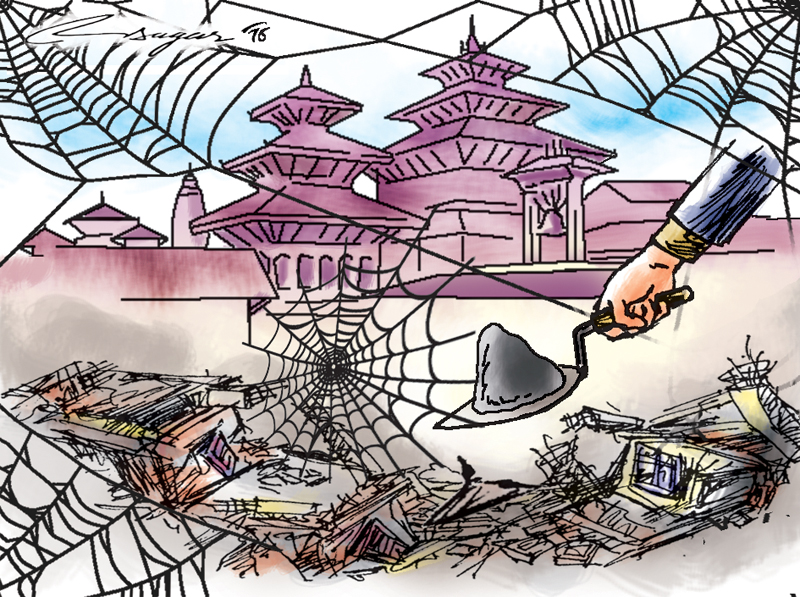Long hibernation: Many things to do
The government should be conscious about the use of cooperatives principles for reconstruction efforts, resources could be shared among the victims where ever they are and the labour exchange could be effectively practiced
In commemoration of the devastating 25 April, 2015 Gorkha earthquake, stakeholders are seemingly planning to light candles with gossips of rapid but tepid reconstruction!
As the previous government sanctioned around a billion dollar budget for ‘relief, rehabilitation and reconstruction’ however, it hasn’t spilled over anywhere in between Barpak to Kodari.
The national reconstruction authority (NRA) is still pondering over the so-called planning and recruitment, a sluggish move comparable to Haiti in the global panorama.
The PM declared he would reconstruct the Dharahara tower, yet it is waiting for the foundation stone and everyday dwellings are flying with some architectural, colourful but untested and possible but not justified emotional drawings.
Is Nepal government virtually ruled by some funding agencies? The government has enrolled in the bureaucracy thousands of civil and structural engineers, yet the government is recruiting consultants just to do some computer aided designs.
Everyday people always question what the heck the government employees civil and structural engineers are doing then as it is not able to draft, analyze, justify and approve the designs?
The hibernation of government is backed largely by the soporific bureaucracy and aloof political leadership.
One year is a big loss for a nation which wants to graduate soon to a developing state and plans rapid economic growth.
High dependence and the government’s unrelenting expectations have converted the medium loss into enormous loss and a challenge of reconstruction as critical as that of Haiti.
This was inevitable and easily justifiable with the government’s steps in the past few decades. The Nepalese government expects some bucks and reconstruction is a big deal!
The common concern is where is the budget sanctioned in July wandering till now? Surely, with the bureaucracy! With such yawning bureaucrats, construction of cow sheds may exceed one year.
Construction of almost three quarter million edifices is a dream for the aloof bureaucracy and begging mindset.
Apart from the negations, Nepal still has hope to reconstruct with the least possible foreign aid through cooperative frameworks.
Indeed cooperative frameworks, community forestry, volunteerism and altruism could be the four corners of dilapidated post-quake reconstruction.
The Indian state of Gujarat reconstructed 1.2 million houses within the proper time frame and the astonishing success story of reconstruction is lauded across the globe. It is high time for Nepal government and bureaucracy to show integration, efficiency, service and patriotism.
If the government pedals on the reconstruction field, people will surely congregate to finish the race, a paradigm could be effective to see, how Modi’s sweeping practice was followed by thousands.
Why do the Nepalese leaders not plan to work in reconstruction projects along with their cadres? It is obvious that, universities could contribute with their students, lecturers could invite their pupils, and athletes could do their practice session on the reconstruction ground and so on.
The NRA is already ruined due to lack of apolitical, workaholic and conceptual mindsets.
Unlike the common principles and expectations recruitment of cadres might overturn the reconstruction milieu, NRA shouldn’t be established for rebuilding houses for UML, Congress or the Maoists.
At this time, the government should be conscious about the use of cooperatives principles for reconstruction efforts, resources could be shared among the victims where ever they are and the labour exchange could be effectively practiced.
People have dreams as the government has printed on some flexes with architectural flavours.
However reconstruction may meet their expectations due to the fact that people can’t wait for years to reconstruct single storied/two storied houses as per the government and its employees’ installment concept.
Almost 70% people could have till date reconstructed their own houses if some technical supports were provided and reimbursements were assured.
However, the government seems reluctant to ask people to reconstruct themselves. Rather several legal steps and bills were put forth turning a deaf ear towards the people beneath the tarps and temporary shelters.
The consequences of overly politicized social dynamics and resource constraints, along with the dependence to every single bricks to be lifted by the government will hamper the rapid reconstruction.
Post-quake reconstruction shouldn’t be like the Melamchi project. Going through cooperatives framework by eyeing seismic safety, other interacting hazards and their countermeasures will be an effective tool for participatory reconstruction framework.
Nepal should learn lessons from Haiti, Gujarat and others but it’s never obligatory to follow the same framework but to develop some participatory and welfare based reconstruction approach.
Till date, only earthquake effects are emphasized and other disasters like floods, landslides, among others, are devalued in policy making to planning. Sagacious planning is needed right now so as kick off wise reconstruction.
The writer is a PhD researcher in Structural Earthquake Engineering






